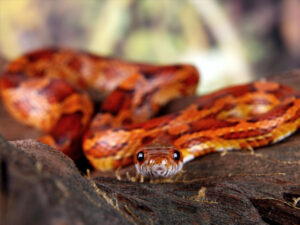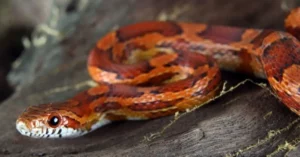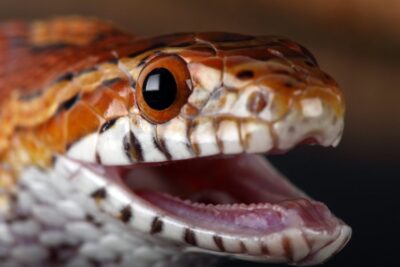In the mesmerizing world of reptiles, the Corn Snake stands as a popular and captivating species, admired for its vibrant colors, mild temperament, and intriguing behavior. As enthusiasts delve into the details of these slithering companions, questions arise, and one common inquiry that piques curiosity is, “Do Corn Snakes have teeth?”
This seemingly straightforward question unveils a fascinating aspect of these reptiles’ anatomy, shedding light on the intricacies of their dental structure and offering insights into their feeding habits.
Keep reading as you are about to discover the dental mysteries of Corn Snakes and unravel the secrets behind their seemingly harmless smiles.
Do corn snakes have teeth?

Yes, corn snakes do have teeth. However, their teeth are not venomous and are not designed for injecting venom into their prey. Instead, corn snakes have rows of small, recurved teeth that help them grasp and swallow their prey.
These teeth are located in the upper jaw and are used to catch and hold onto the prey while the snake maneuvers it into a position to be swallowed whole.
While the teeth of corn snakes are not harmful to humans, it’s always a good idea to handle any snake with care to avoid getting bitten. If you’re considering owning a corn snake or any other snake species as a pet, it’s important to research their care requirements and behavior to ensure you provide them with a suitable environment and handle them safely.
Types of teeth in corn snakes
Corn snakes, like most snakes, are known for having specialized teeth designed for capturing and consuming their prey. Snakes have different types of teeth, each serving a specific function in the process of capturing, subduing, and swallowing prey.
Here are the main types of teeth found in corn snakes:
- Rearward-pointing teeth (maxillary teeth): These teeth are located along the upper jaw (maxilla) and are typically longer and more curved than the other teeth. They help in grasping and holding onto prey. Once the snake has captured its prey, these teeth prevent it from escaping.
- Grooved or hollow teeth (rear fangs): Corn snakes, along with many other colubrid snakes, have rear fangs. These fangs are located towards the back of the upper jaw and are grooved rather than hollow like those of venomous snakes. The grooves aid in the transport of saliva containing mild venom from salivary glands to the prey. This mild venom helps in subduing and digesting prey.
- Small, recurved teeth (dentary teeth): These teeth are found on the lower jaw (dentary). They are also involved in grasping and holding onto prey. While not as prominent as the rearward-pointing maxillary teeth, the dentary teeth contribute to the snake’s ability to secure and manipulate its food.
In addition, corn snakes are non-venomous and rely on constriction to subdue their prey rather than venom. The mild venom produced by their rear fangs aids in breaking down the tissues of the prey and facilitating digestion.
Remember that the teeth of corn snakes are not used for chewing; instead, they play a crucial role in capturing, restraining, and preparing prey for ingestion through the snake’s unique method of swallowing prey whole.
Function of Teeth in Corn Snakes
The teeth of corn snakes, like those of many other snakes, serve several important functions that are essential for their survival and feeding habits.
Here are the primary functions of teeth in corn snakes:
- Capturing Prey: The teeth of corn snakes, especially the rearward-pointing maxillary teeth, play a crucial role in capturing prey. These teeth are designed to grab and hold onto the snake’s prey, preventing it from escaping.
- Subduing Prey: While corn snakes are non-venomous, they possess grooved or hollow rear fangs that produce mild venom. This venom is not harmful to humans but aids in subduing their prey. The grooves in the rear fangs allow the venom to flow into the wounds caused by the bite, helping to immobilize and start the digestive process.
- Swallowing Prey Whole: Corn snakes, like all snakes, are unable to chew their food. Instead, they swallow their prey whole. The teeth assist in manipulating and guiding the prey into the snake’s mouth. Once the prey is secured, the snake uses its powerful muscles to engulf the prey.
- Preventing Escape: The rearward-pointing teeth, particularly the maxillary teeth, are instrumental in preventing prey from escaping. These teeth act like tiny barbs, making it difficult for the prey to slip out of the snake’s grasp.
- Aiding in Digestion: The mild venom produced by the rear fangs serves not only to subdue prey but also to initiate the digestive process. The venom helps break down the tissues of the prey, making it easier for the snake to digest.
It’s important to note that corn snakes are constrictors, meaning they use their powerful body muscles to squeeze and immobilize their prey.
The teeth play a vital role in the initial capture and retention of the prey before the snake proceeds to swallow it whole. Additionally, the rear fangs and venom contribute to the snake’s ability to handle and digest a variety of prey items.
Corn Snake Dentition Compared to Other Snakes

Corn snakes (Pantherophis guttatus) are non-venomous colubrid snakes native to North America. Like other snakes, corn snakes have specialized dentition adapted to their feeding habits. Snake dentition can vary among species, but there are some general characteristics that can be compared.
- Aglyphous Dentition (Non-venomous Snakes like Corn Snakes):
-
- Teeth Arrangement: Corn snakes have aglyphous dentition, meaning they lack specialized fangs associated with venom delivery. Instead, they have numerous small, recurved teeth along both the upper and lower jaws.
- Function: These teeth are used for gripping and swallowing prey whole. Corn snakes typically feed on rodents, birds, and other small animals.
- Opisthoglyphous Dentition (Rear-Fanged Venomous Snakes):
-
- Examples: Boomslangs and Twig Snakes.
- Teeth Arrangement: These snakes have enlarged, grooved rear fangs located at the back of the upper jaw.
- Function: The rear fangs are used to inject venom into prey. The venom contains toxins that aid in subduing and digesting the prey.
- Proteroglyphous Dentition (Front-Fanged Venomous Snakes):
-
- Examples: Cobras, kraits, and coral snakes.
- Teeth Arrangement: Front-fanged snakes have short, fixed fangs located at the front of the upper jaw.
- Function: These snakes can deliver venom through these hollow fangs, which are used to subdue and immobilize prey.
- Solenoglyphous Dentition (Front-Fanged Venomous Snakes with Hinged Fangs):
-
- Examples: Vipers and pit vipers.
- Teeth Arrangement: Vipers have long, hinged fangs located at the front of the upper jaw.
- Function: The fangs are hinged and fold back against the roof of the mouth when not in use. When biting, the fangs swing forward to inject venom into the prey.
Do Corn Snakes Have Venomous Teeth?
No, corn snakes (Pantherophis guttatus) are not venomous. They belong to the family Colubridae, which generally consists of non-venomous snakes. Corn snakes have what is known as aglyphous dentition, meaning they lack specialized fangs for delivering venom. Instead, they have numerous small, recurved teeth along both their upper and lower jaws.
Corn snakes are constrictors, and they subdue their prey by coiling around it and squeezing. Their teeth are primarily used for gripping and holding onto their prey rather than injecting venom. The prey is then swallowed whole.
While corn snakes are not harmful to humans in terms of venom, they may bite if they feel threatened or stressed. However, their bites are generally harmless and are more like scratches, as they do not inject venom.
As with any pet, it’s essential to handle corn snakes gently and with respect for their natural behaviors to minimize stress for both the snake and the handler.
Signs of dental issues in corn snakes

Dental issues in corn snakes, as in other reptiles, can be challenging to diagnose because their teeth are relatively small and located within their mouths. However, there are some signs and behaviors that may indicate potential dental problems in corn snakes:
- Decreased Appetite:
- A sudden or prolonged loss of appetite can be an indication of dental issues. If the snake is experiencing pain while eating due to dental problems, it may avoid feeding.
- Difficulty Swallowing:
- If a corn snake has trouble swallowing its prey or exhibits repeated regurgitation, it could be a sign of dental issues affecting its ability to consume and process food.
- Excessive Drooling or Salivation:
- Excessive saliva or drooling can be a sign of oral issues, including dental problems. If you notice an unusually wet mouth, it may warrant a closer examination.
- Unusual Behavior During Feeding:
- If the snake seems hesitant to strike at or consume its prey, it might be experiencing pain or discomfort associated with dental problems.
- Mouth Abnormalities:
- Visible signs of mouth abnormalities, such as swelling, redness, or lesions inside the mouth, may indicate dental issues or other oral health problems.
- Changes in Behavior:
- Unexplained changes in behavior, such as increased aggression, restlessness, or lethargy, could be associated with pain or discomfort in the mouth.
- Difficulty Shedding:
- Dental issues can sometimes be related to overall health problems, and if a corn snake is having difficulty shedding its skin, it may be indicative of an underlying health issue.
If you observe any of these signs in your corn snake, it’s crucial to consult with a veterinarian experienced in reptile care. A vet can perform a thorough examination, including an inspection of the snake’s mouth, to identify any dental issues or other health concerns.
Regular veterinary check-ups and a proper diet can contribute to the overall well-being of your corn snake and help prevent or address potential dental problems.
Tips for promoting good dental hygiene in captive corn snakes
Promoting good dental hygiene in captive corn snakes is essential for their overall health and well-being. Here are some tips to help maintain healthy teeth in captive corn snakes:
- Provide a Proper Diet:
-
- Feed your corn snake a well-balanced diet that includes appropriately sized prey items. This helps ensure they get the necessary nutrients for overall health, including dental health.
- Variety in Prey Items:
-
- Offering a variety of prey items can help promote dental health by encouraging the use of different chewing muscles and preventing nutritional imbalances.
- Calcium Supplementation:
-
- Ensure your corn snake receives adequate calcium supplementation. Calcium is essential for bone and dental health. You can dust prey items with a calcium supplement before feeding.
- Maintain Optimal Husbandry Conditions:
-
- Proper temperature and humidity levels are crucial for the overall health of your corn snake, including its oral health. Inadequate environmental conditions can contribute to stress and health issues, including dental problems.
- Provide Adequate Cage Furniture:
-
- Include cage furniture such as branches or hides that encourage natural behaviors like climbing and exploring. This can help maintain the overall health of your snake, including its teeth.
- Regular Health Check-ups:
-
- Schedule regular check-ups with a reptile veterinarian experienced in snake care. They can examine your snake’s mouth and teeth for any signs of abnormalities or dental issues.
- Monitor for Signs of Dental Issues:
-
- Keep a close eye on your corn snake for any signs of dental problems, such as decreased appetite, difficulty swallowing, or changes in behavior. Early detection can help address issues before they become severe.
- Maintain Clean Living Conditions:
-
- Ensure the snake’s enclosure is kept clean. Dirty living conditions can contribute to bacterial infections, which may affect the oral health of your snake.
- Offer a Water Dish:
-
- Provide a clean water dish for your corn snake. Proper hydration is essential for overall health, including the health of the oral cavity.
- Avoid Overfeeding:
-
- Overfeeding can lead to obesity, which can have negative effects on a snake’s overall health, including dental health. Follow a feeding schedule appropriate for your snake’s age and size.
Remember that prevention is key, and providing a well-rounded and appropriate environment for your corn snake can contribute to good dental hygiene. If you suspect any dental issues or notice changes in your snake’s behavior, consult with a reptile veterinarian promptly.
Conclusion
There are so much misconception on corn snake dentition and here on this page, we have the answer to the question do corn snakes have teeth. They possess numerous small, recurved teeth along both their upper and lower jaws. However, these teeth are not venomous, as corn snakes are non-venomous colubrids.
Their teeth are adapted for gripping and holding onto prey, aiding in the process of swallowing whole prey items. While corn snakes are not harmful to humans in terms of venom, they may bite if threatened or stressed, with bites being generally harmless and more like scratches.

